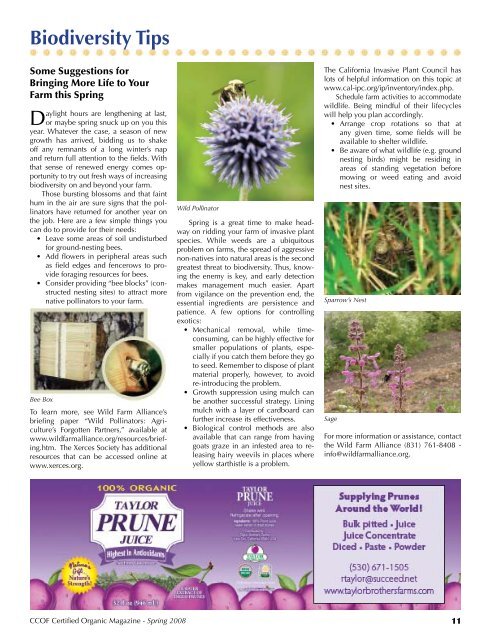Member ProfilesAlaska’s BakeryCCOF knows that many of our certifiedmembers are dog lovers and thoughtyou’d be interested to hear the story ofCCOF certified Alaska Bakery that makesgourmet dog treats. Here’s a questionand answer session with Noreen Naidus,founder and owner.Q: What prompted you to set up a bakerymaking dog biscuits?A: It all began when Alaska joined the familyas a six week old puppy. His parentswere championship American Eskimo dogs.We got him from Alaska, hence his name.All my life, I’ve had a strong interest in nutritionand health and I’ve loved to cookand bake. When we got Alaska, I wantedNoreen Naidus and her dog Alaskato make sure that we took good care of himand fed him food that would ensure him along and healthy life. I started to read-up onwhat foods were good and what to avoidand started to bake my own dog cookieswhen I found there was nothing availablethat met my standards. Making batches ofdog treats resulted in more treats than onedog could eat and that’s when the idea ofstarting a bakery came about. Since Alaskawas the inspiration we decided to name thebakery after him.Q: How did you go about researching whatingredients to use?A: My research consisted of reading lots ofbooks and asking lots of questions. I foundthe answers I was looking for in books byholistic veterinarians. Then I experimentedwith ingredients and flavors using Alaskaand the other neighborhood dogs to tastetest. I started by feeding him a carrot, a dateor other piece of dried fruit. When he wentreally crazy I knew I had a winner.Q: What are some of the health benefits fordogs of the ingredients you use?A: Organic ingredients are more easily digested,offer the body more nutrients andmake for a stronger immune system, all ofwhich help enhance the quality of and extendthe life of an animal. For example, Ihave a recipe using cranberries which containpowerful antioxidants that benefit thecardiovascular system and immune system.It’s all about combining flavor with what’swholesome and healthy.Alaska’s now eight yearsold - ‘going on two’ – andI’m confident this is duein large part to his diet.Q: Why did you decide tobecome certified organicby CCOF?A: It was a commercialdecision. I wanted to givepeople a product theycould trust, and I wantedto give myself an edgewith which I could approachstores and retailersand get noticed. The decisionto become certifiedorganic is one that’s trulypaid off. The veterinarianwho endorses my productused to sell around six bags a week, sincewe became certified organic they are nowselling three cases a week.Q: What did you find most easy and mostdifficult about the certification process?A: The easy part was making the decisionto become certified organic. After that thechallenge was to learn all about the NOPrules and regulations, what was allowedand not allowed, and then to ensure thatwhat I’d been doing instinctively before metthe legal organic standards. As we’ve grownlarger we’ve had to work harder on documentation.When production was small itwas easy to know when the last batch wasmade and for whom: now that we’re bigger,record keeping takes more effort. Sourcingingredients was another challenge.Q: What can youtell consumersabout the USDANational OrganicProgram (NOP)standards for petfoods?A: The same setof standards andrules apply tothe production ofAlaska’s Bakery Dog Treatsorganic dog foodas to the production of organic food forhuman consumption. The laws governingingredients, processing aids, storage andhandling are all the same. This makes totalsense to me. Why should the standards thatapply to their animals be any different tothose for any other member of the family?I do wish the USDA would do more totell consumers about labeling differenceson organic food, so that people could understandbetter what they mean.Q: What is the flavor of the month club?A: I wanted to offer my customers, dogsand owners, variety and choice, so I cameup with the dog biscuit equivalent to awine club. Customers who join the Clubautomatically get a delivery once a month,a new dog biscuit flavor in the shape of themain ingredient. For example, apple flavorbiscuits are in the shape of an apple. Theclub is a fun way to promote other recipesin addition to our five standard flavors.Q: Where can dog lovers go to buy yourproducts for their pets?A: At present, select Whole Foods stores inLas Vegas and Henderson, Nevada, stockour product. We’ll be going regional withWhole Foods in the near future. A numberof small independently owned pet storesthroughout the country also carry our treats.The full list of retail outlets can be found onour website, you can also buy direct fromus online. Who would have thought thatmaking a biscuit for Alaska would becomea business? It’s a dream come true.For further information on Alaska Bakeryvisit www.alaskasbakery.com or telephone(702) 362-446610 CCOF Certified Organic Magazine - Spring 2008
Biodiversity TipsSome Suggestions forBringing More Life to YourFarm this SpringDaylight hours are lengthening at last,or maybe spring snuck up on you thisyear. Whatever the case, a season of newgrowth has arrived, bidding us to shakeoff any remnants of a long winter’s napand return full attention to the fields. Withthat sense of renewed energy comes opportunityto try out fresh ways of increasingbiodiversity on and beyond your farm.Those bursting blossoms and that fainthum in the air are sure signs that the pollinatorshave returned for another year onthe job. Here are a few simple things youcan do to provide for their needs:• Leave some areas of soil undisturbedfor ground-nesting bees.• Add flowers in peripheral areas suchas field edges and fencerows to provideforaging resources for bees.• Consider providing “bee blocks” (constructednesting sites) to attract morenative pollinators to your farm.Bee BoxTo learn more, see Wild Farm Alliance’sbriefing paper “Wild Pollinators: Agriculture’sForgotten Partners,” available atwww.wildfarmalliance.org/resources/briefing.htm.The Xerces Society has additionalresources that can be accessed online atwww.xerces.org.Wild PollinatorSpring is a great time to make headwayon ridding your farm of invasive plantspecies. While weeds are a ubiquitousproblem on farms, the spread of aggressivenon-natives into natural areas is the secondgreatest threat to biodiversity. Thus, knowingthe enemy is key, and early detectionmakes management much easier. Apartfrom vigilance on the prevention end, theessential ingredients are persistence andpatience. A few options for controllingexotics:• Mechanical removal, while timeconsuming,can be highly effective forsmaller populations of plants, especiallyif you catch them before they goto seed. Remember to dispose of plantmaterial properly, however, to avoidre-introducing the problem.• Growth suppression using mulch canbe another successful strategy. Liningmulch with a layer of cardboard canfurther increase its effectiveness.• Biological control methods are alsoavailable that can range from havinggoats graze in an infested area to releasinghairy weevils in places whereyellow starthistle is a problem.The California Invasive <strong>Plan</strong>t Council haslots of helpful information on this topic atwww.cal-ipc.org/ip/inventory/index.php.Schedule farm activities to accommodatewildlife. Being mindful of their lifecycleswill help you plan accordingly.• Arrange crop rotations so that atany given time, some fields will beavailable to shelter wildlife.• Be aware of what wildlife (e.g. groundnesting birds) might be residing inareas of standing vegetation beforemowing or weed eating and avoidnest sites.Sparrow’s NestSageFor more information or assistance, contactthe Wild Farm Alliance (831) 761-8408 -info@wildfarmalliance.org.CCOF Certified Organic Magazine - Spring 200811
















